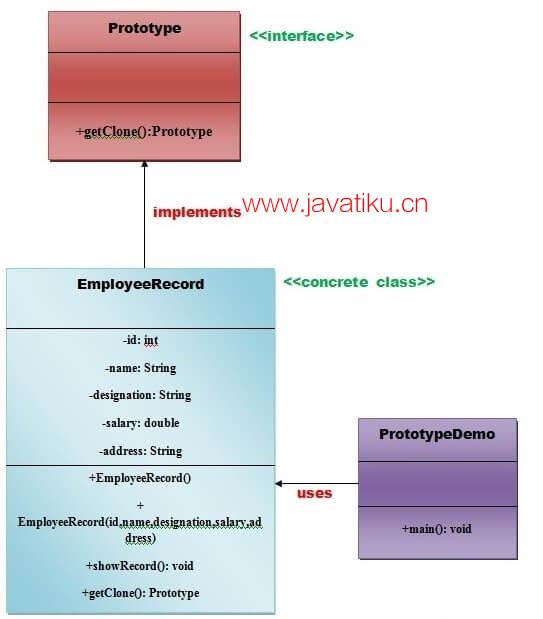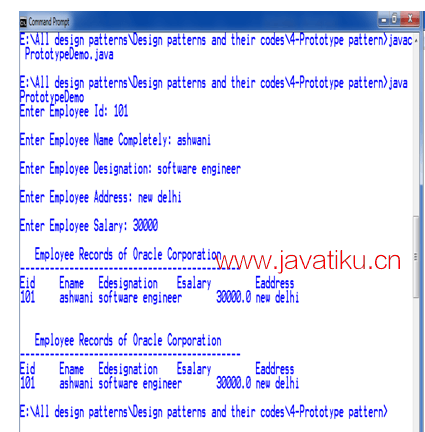Design Patterns教程-原型设计模式

原型模式表示克隆一个现有对象而不是创建一个新的对象,并且可以根据需要进行定制。
如果创建一个新对象的成本昂贵且资源密集,则应遵循此模式。
原型模式的优点
原型模式的主要优点如下:
- 它减少了子类化的需要。
- 它隐藏了创建对象的复杂性。
- 客户端可以获得新对象而无需知道将是什么类型的对象。
- 它允许你在运行时添加或删除对象。
原型模式的使用场景
- 当类在运行时被实例化时。
- 当创建一个对象的成本昂贵或复杂时。
- 当你想在应用程序中保持类的数量最少时。
- 当客户端应用程序需要不了解对象的创建和表示时。
原型模式的 UML

- 我们将创建一个包含 getClone() 方法的 Prototype 接口。
- 然后,我们将创建一个实现 Prototype 接口的具体类 EmployeeRecord,它负责克隆 EmployeeRecord 对象。
- PrototypeDemo 类将使用这个具体类EmployeeRecord。
原型设计模式的示例
让我们看看原型设计模式的示例。
文件:Prototype.java
interface Prototype {
public Prototype getClone();
} // Prototype 接口结束文件:EmployeeRecord.java
class EmployeeRecord implements Prototype {
private int id;
private String name, designation;
private double salary;
private String address;
public EmployeeRecord() {
System.out.println(" Employee Records of Oracle Corporation ");
System.out.println("---------------------------------------------");
System.out.println("Eid" + "\t" + "Ename" + "\t" + "Edesignation" + "\t" + "Esalary" + "\t\t" + "Eaddress");
}
public EmployeeRecord(int id, String name, String designation, double salary, String address) {
this();
this.id = id;
this.name = name;
this.designation = designation;
this.salary = salary;
this.address = address;
}
public void showRecord() {
System.out.println(id + "\t" + name + "\t" + designation + "\t" + salary + "\t" + address);
}
@Override
public Prototype getClone() {
return new EmployeeRecord(id, name, designation, salary, address);
}
} // EmployeeRecord 类结束文件:PrototypeDemo.java
import java.io.BufferedReader;
import java.io.IOException;
import java.io.InputStreamReader;
class PrototypeDemo {
public static void main(String[] args) throws IOException {
BufferedReader br = new BufferedReader(new InputStreamReader(System.in));
System.out.print("Enter Employee Id: ");
int eid = Integer.parseInt(br.readLine());
System.out.print("\n");
System.out.print("Enter Employee Name: ");
String ename = br.readLine();
System.out.print("\n");
System.out.print("Enter Employee Designation: ");
String edesignation = br.readLine();
System.out.print("\n");
System.out.print("Enter Employee Address: ");
String eaddress = br.readLine();
System.out.print("\n");
System.out.print("Enter Employee Salary: ");
double esalary = Double.parseDouble(br.readLine());
System.out.print("\n");
EmployeeRecord e1 = new EmployeeRecord(eid, ename, edesignation, esalary, eaddress);
e1.showRecord();
System.out.println("\n");
EmployeeRecord e2 = (EmployeeRecord) e1.getClone();
e2.showRecord();
}
} // PrototypeDemo 类结束输出




